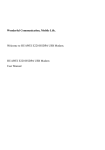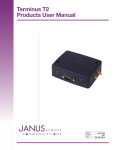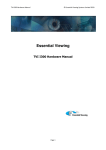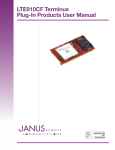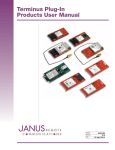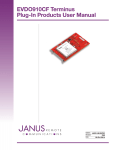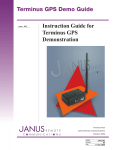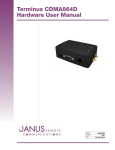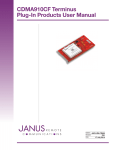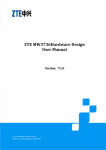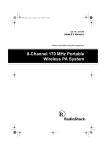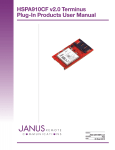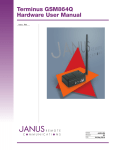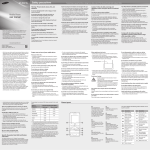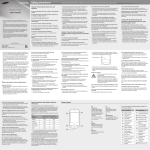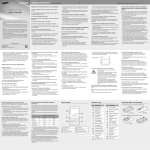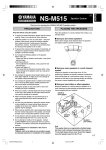Download Terminus T3 Products User Manual
Transcript
Terminus T3 Products User Manual Bulletin Revision Date JA19-UM A00 01 July 2015 TABLE OF CONTENTS TABLE OF CONTENTS and DISCLAIMER............................................................................................................................... 2 T3 General Description............................................................................................................................................................ 3 Block Diagram......................................................................................................................................................................... 3 T3 Overview............................................................................................................................................................................. 3 T3 Connections..................................................................................................................................................................... 3-5 Terminals RS232 USB LED Indicators Antenna Connections SIM Card T3 Electrical Specifications................................................................................................................................................... 6-8 Absolute Maximum Ratings Recommended Operating Conditions Cellular Antenna Specifications GPS Antenna Specifications Mechanical Specifications....................................................................................................................................................... 9 Getting started with T3 Terminus Applications................................................................................................................. 10-13 Starting a Terminal Session Sending an SMS Making a GPRS Data Call GPS Ordering Information.............................................................................................................................................................. 14 Revision History..................................................................................................................................................................... 14 DISCLAIMER The information contained in this document is the proprietary information of Connor-Winfield Corporation and its affiliates (Janus Remote Communication). The contents are confidential and any disclosure to persons other than the officers, employees, agents or subcontractors of the owner or licensee of this document, without the prior written consent of Connor-Winfield, is strictly prohibited. Connor-Winfield makes every effort to ensure the quality of the information it makes available. Notwithstanding the foregoing, Connor-Winfield does not make any warranty as to the information contained herein, and does not accept any liability for any injury, loss or damage of any kind incurred by use of or reliance upon the information. Connor-Winfield disclaims any and all responsibility for the application of the devices characterized in this document, and notes that the application of the device must comply with the safety standards of the applicable country, and where applicable, with the relevant wiring rules. ConnorWinfield reserves the right to make modifications, additions and deletions to this document due to typographical errors, inaccurate information, or improvements to programs and/or equipment at any time and without notice. Such changes will, nevertheless be incorporated into new editions of this application note. All rights reserved 2011 Connor-Winfield Corporation Terminus T3 User Guide JA19-UM Page 2 Rev: A00 Date: 07/01/15 © Copyright 2015 Janus Remote Communications Specifications subject to change without notice All Rights Reserved See website for latest revision. Not intended for life support applications. T3 Terminus Description The Terminus T3 is a communication control terminal with a compact, rugged enclosure that encapsulates everything needed for easy M2M integration. The multiple orderable versions allow for system deployment in different networks with little to no change in the design investment. Powered by the Terminus Common Footprint devices, the T3 contains all circuitry required to give your application access to GSM, HSPA, EVDO, even LTE based network technology. It can receive power from a 5v source, contains two communication interfaces, and an easy to use input to control ON/OFF remotely. Additionally, Janus offers Python examples for the modems equipped with the interpreter to add scripting capabilities to your application. T3 Connections Terminals The 4 position terminal section serves as the power supply input. It is also the access point for the external disable input. Janus carries mating connectors for the terminal block, but the part number is referenced for the user if they need to find something we do not carry. Pin Description 1 2 3 4 External Disable Ground Ground 5V Supply Terminal Part Number: OSTOQ041251 Figure 1: T3 Terminal Block Diagram External Disable This input signal is designed to put the unit into the lowest possible power state without needing to cut power entirely. It can be used by simply grounding the signal, then released when not needed. This signal is internally pulled up to 5v. It should only be controlled via grounding or floating. Terminus T3 User Guide JA19-UM Page 3 Rev: A00 Date: 07/01/15 © Copyright 2015 Janus Remote Communications Specifications subject to change without notice All Rights Reserved See website for latest revision. Not intended for life support applications. T3 Connections continued RS232 The DB9 port follows the standard for RS-232 communications and gives the connections for serial interaction with hardware handshaking. Pin Description Direction 1 2 3 4 5 6 7 8 9 DCD RXD TXD DTR GND DSR RTS CTS RING Output Output Input Input Supply Output Input Output Output USB The USB B type port is directly connected to the modem, giving several interfaces in one connection for application ease. This port can be used for various functions, including firmware updates of the modem. This port does not provide power to the T3, which must come from the main terminal input. LED Indicators The T3 contains two LEDs for feedback to the user. Status – Green LED This LED is T3 feedback on readiness of the modem to accept commands, and is automatically controlled internally. When the unit is available for communications this will be illuminated. When the modem is not ready, either through external disable control or the use of low power AT+CFUN modes this LED will be turned off. Logically, it is tied to the CTS (clear to send) signal. Cellular – Amber LED This LED is directly connected to the modem’s cellular status signal. It can be user controlled through AT commands, or set to automatic control by the modem for cellular status feedback. Please consult the modem AT command guide for control commands. AT#GPIO and AT#SLED are the common commands. Description of status: LED Status Permanently Off Permanently On Slow Blinking (0.3 sec on / 2.7 sec off) Fast Blinking (0.5 sec on / 0.5 sec off) Device Status Cellular radio is off On/Searching Registered Shutting down Terminus T3 User Guide JA19-UM Page 4 Rev: A00 Date: 07/01/15 © Copyright 2015 Janus Remote Communications Specifications subject to change without notice All Rights Reserved See website for latest revision. Not intended for life support applications. T3 Connections continued Antenna Connections These are bulkhead antenna connections for wireless communication to cellular and GPS technology. SMA Cellular and RX Diversity antenna connections Pin Description Center Pin Shield Signal Ground MCX GPS antenna connection Pin Description Center Pin Shield Signal Ground SIM Card The SIM card port is located inside of the T3, on the module itself. To insert a SIM card, please follow these instructions. Step 1. To access the SIM card holder, remove the four TX-10 screws from the ruggedized aluminum enclosure. These screws are located on the panel of the T3 that includes the RS232 DB9 and RF connections. Step 2. Slide out the panel which will include the T3 board. Step 3. Locate the SIM card holder on top of the Terminus Plug-In board. Step 4. Slide the top of the SIM card holder back to unlock, insert the SIM card and close. Slide back to the original position to lock back in place. Step 5. Slide the panel back into the enclosure, replace, and tighten the four TX-10 screws. Terminus T3 User Guide JA19-UM Page 5 Rev: A00 Date: 07/01/15 © Copyright 2015 Janus Remote Communications Specifications subject to change without notice All Rights Reserved See website for latest revision. Not intended for life support applications. Electrical Specifications: Absolute Maximum Ratings: Parameter Minimum Nominal Maximum Unit Note Storage Temperature Supply (Supply & Enable Input) VIN (RS-232 Inputs) -40 0 -25 - - - 85 6 25 °C Volt Volt 1 1,2 1 Notes: 1) Operation of the device at these or any other conditions beyond those listed under Recommended Operating Conditions is not implied. Exposure to Absolute Maximum Rating conditions for extended periods of time may affect device reliability. 2) The supply inputs are protected from transients beyond the Recommended Operating Conditions. If transients persist the supply will be latched in a disable state until the input is lowered. Recommended Operating Conditions: Parameter Minimum Nominal Maximum Unit Note Operational Temperature: Supply Peak Supply Current -40 4.75 1.5 25 5.0 - 80 5.25 - °C Volt Amp 1 Mode Type Terminal Disabled - Average (mA) Description .140External Disable Grounded, modem off. Using: RS-232 AT+CFUN=1 WCDMA 34 Idle, no call in progress. Full functionality of GSM - the module AT+CFUN=4 WCDMA 33 Disabled TX and RX; module is not registered GSM - on the network AT+CFUN=5 WCDMA 10Full functionality with power saving; Module registered GSM - on the network can receive incoming call sand SMS AT+CFUN=0 WCDMA 10Minimum functionality. In this mode the AT interface GSM - is not accessible. Must be woken up externally by SMS or Socket attempt. Using: USB AT+CFUN=1 AT+CFUN=4 AT+CFUN=0 WCDMA 38 GSM - WCDMA 37 GSM - WCDMA 5 GSM- Idle, no call in progress. Full functionality of the module. Disabled TX and RX; module is not registered on the network Full functionality with power saving; Module registered on the network can receive incoming call sand SMS Using: RS-232 & USB AT+CFUN=1 WCDMA 51Idle, no call in progress. Full functionality of GSM - the module. AT+CFUN=4 WCDMA 51Disabled TX and RX; module is not registered on the GSM - network AT+CFUN=5 WCDMA 11 Full functionality with power saving; Module registered GSM - on the network can receive incoming call sand SMS AT+CFUN=0 WCDMA 10 Minimum functionality. In this mode the AT interface GSM - is not accessible. Must be woken up externally by SMS or Socket attempt. Notes: 1)Peak Supply Current specification is stated as the minimum amount of current the external power supply must be able to supply during the TX burst of the embedded cellular radio. Please refer to the Plug-In User Manual for power supply characteristics of the embedded Plug-In Module in the Terminus T3. Plug-In User Manual can be downloaded at http://www.janus-rc.com/terminuscf.html 2)Average Supply Current specification is stated as the maximum average current the Terminus T3 terminal can draw while maintaining junction temperatures within the internal power supply IC’s specifications. It is the applications responsibility to maintain operation within this limit to maintain reliable operation over the life of this terminal product. 3)Values taken with GPS turned OFF. When GPS is used, expect a 20mA increase during operating states. Terminus T3 User Guide JA19-UM Page 6 Rev: A00 Date: 07/01/15 © Copyright 2015 Janus Remote Communications Specifications subject to change without notice All Rights Reserved See website for latest revision. Not intended for life support applications. Electrical Specifications continued Cellular Antenna Specifications: Parameter HSPA910T3 Description Frequency Range Bandwidth Gain Impedance Input Power VSWR Absolute Max VSWR Recommended Depending on frequency bands provided by the network operator, the customer should use the most suitable antenna for those frequencies. 70MHz in GSM850 80 MHz in GSM900 170 MHz in DCS & 140 MHz PCS 70 MHz in WCDMA850 80 MhHz in WCDMA900 460 MHz in WCDMA1700 140 MHz in WCDMA1900 250 MHz in WCDMA2100 Gain < 3dBi 50W >33 dBm (2W) peak power in GSM >24 dBm Average power in WCDMA ≤ 5:1 ≤ 5:1 EVDO910T3 Frequency Range Bandwidth Gain Impedance Input Power VSWR Absolute Max VSWR Recommended Depending on frequency bands provided by the network operator, the customer should use the most suitable antenna for those frequencies. 70MHz in CDMA BC0 140 MHz in CDMA BC Gain < 5dBi 50W > 24.4 dBm in CDMA ≤ 5:1 ≤ 2:1 CDMA910T3 Frequency Range Bandwidth Gain Impedance Input Power VSWR Absolute Max VSWR Recommended Depending on frequency bands provided by the network operator, the customer should use the most suitable antenna for those frequencies. 70MHz in CDMA BC0 140 MHz in CDMA BC Gain < 5dBi 50W > 24.4 dBm in CDMA ≤ 5:1 ≤ 2:1 Terminus T3 User Guide JA19-UM Page 7 Rev: A00 Date: 07/01/15 © Copyright 2015 Janus Remote Communications Specifications subject to change without notice All Rights Reserved See website for latest revision. Not intended for life support applications. Electrical Specifications continued Cellular Antenna Specifications: LTE910T3 – AT&T Frequency Range Bandwidth Gain Impedance Input Power VSWR Absolute Max VSWR Recommended Depending on frequency bands provided by the network operator, the customer should use the most suitable antenna for those frequencies. GSM850: 70Mhz GSM1900 (PCS): 140Mhz WCDMA 1900 (B2): 140Mhz WCDMA 850 (B5): 70Mhz LTE 1900 (B2): 140Mhz LTE 1700 (B4): 445Mhz LTE 850 (B5): 70Mhz LTE 700 (B17): 42Mhz Gain < 3dBi 50Ω >33 dBm (2W) peak power in GSM >24 dBm Average power in WCDMA & LTE ≤ 10:1 ≤ 2:1 LTE910T3 – Verizon Frequency Range Bandwidth Gain Impedance Input Power VSWR Absolute Max VSWR Recommended Depending on frequency bands provided by the network operator, the customer should use the most suitable antenna for those frequencies. LTE 1700 (B4): 445Mhz LTE 700 (B13): 41Mhz Gain < 3dBi 50Ω >24 dBm Average power ≤ 10:1 ≤ 2:1 GPS Antenna Specifications: Parameter GPS Enabled Units Description Input Voltage Range Frequency Range Gain Impedance VSWR Current Consumption 2.85V 1575.42± 2 MHz =< 15dB overall at the connector (Antenna and LNA included) 50Ω TBD 30mA Max, 20mA Typ Terminus T3 User Guide JA19-UM Page 8 Rev: A00 Date: 07/01/15 © Copyright 2015 Janus Remote Communications Specifications subject to change without notice All Rights Reserved See website for latest revision. Not intended for life support applications. Mechanical Specifications: .4491 .2250 2.3500 1.0625 .3250 5.2142 4.1142 1.811 0.790 All measurements in inches unless otherwise noted. Terminus T3 User Guide JA19-UM Page 9 Rev: A00 Date: 07/01/15 © Copyright 2015 Janus Remote Communications Specifications subject to change without notice All Rights Reserved See website for latest revision. Not intended for life support applications. Getting started with the T3 This will take you through the basic steps required to power the Terminus T3 and communicate with the modem. Please confirm that you have these items before continuing. If you are evaluating the GSM or HSPA based T3 ensure that you have an active SIM card. If evaluating the CDMA or EVDO based T3 you will not have a SIM card, but will need an account attached to your device’s MEID which can be found on the bottom of the T3. You can evaluate the basic functions without these steps, but in order to fully evaluate cellular connectivity it is required. • Power Supply with the terminal block mating connection • RS232 DB9 ended cable or USB B to A cable • SMA Cellular Antenna Starting a Terminal Session Step 1 • Attach the cellular antenna to the SMA bulkhead connector. • If applicable, insert the SIM card to the modem’s SIM holder. • Connect the RS232 cable or USB cable to the DB9 or USB connection, respectively. Step 2 Apply power to the T3 via the terminal blocks. The T3 will begin booting the modem, and you will see the amber LED illuminate. In a few moments the green LED should illuminate, indicating the modem is ready to accept commands. Step 3 – Using RS232 Open HyperTerminal or an equivalent terminal emulator and start a new session. Use the following settings as they are the default for T3 communications. Bits per second: 115200 Data Bits: 8 Parity: None Stop Bits: 1 Flow control: Hardware Step 3 – Using USB If this is the first time using this modem type on your PC, you should see several virtual COM ports appear in the device manager. You will want to download the USB drivers for your modem type, which can be found on the Janus-RC website. Once the drivers are installed and the ports are available, you can open a terminal session with the following settings as they are the default for T3 communications. Bits per second: 115200 Data Bits: 8 Parity: None Stop Bits: 1 Flow control: None Terminus T3 User Guide JA19-UM Page 10 Rev: A00 Date: 07/01/15 © Copyright 2015 Janus Remote Communications Specifications subject to change without notice All Rights Reserved See website for latest revision. Not intended for life support applications. Getting started with the T3 continued Starting a Terminal Session continued Step 4 Click on the “Call” button in HyperTerminal to make the connection. In the window you should now be able to send AT commands. To make sure you have a proper connection, type “AT” into the window (without quotes), and press Enter. You should receive a response of “OK”. If you do not receive that response, go back and check to make sure you’ve selected the correct COM port, as well as the settings. Step 5 The next thing is to set the modem for proper operation and wait for registration. Although the modems are factory set by default to work in a wide range, ensuring these are set is still a good idea. GSM and HSPA For T-Mobile & MVNO • AT#SELINT=2 – This makes use of the most recent AT command set • AT#ENS=1 – Ensures some automatic settings used CDMA and EVDO These units require some extra steps that are thoroughly detailed in our Provisioning App Note found here: http://www.janus-rc.com/Documentation/JA01-AN111_Provisioning-CDMA.pdf Step 6 Check the network status by entering “AT+CREG?” without the quotations and press ENTER. The response will be +CREG: 0,1 or +CREG: 0,5 meaning the device is registered to the home network or roaming, respectively. If the response is different than this please refer to the AT Command guide as well as verify the account is active. Step 7 Check the signal quality by entering “AT+CSQ” without the quotations and press ENTER. The response will be +CSQ: <rssi>,<ber> <rssi> Signal Strength 99 Not known or detectable 0-31 dBm = (rssi*2) – 113 Example: A result of 31 indicates -51dBm or greater. An rssi value of >=10 in typical applications if fine and you will usually see about 12-20 in normal to good signal, but note that worst case it can be lower but still register and perform normal functions. Sending an SMS SMS (Select Message Service) mode allows you to send a text message (max 160 characters) to an SMS capable subscriber unit. • Set the SMS mode to text. This must be entered every power cycle. AT+CMGF=1<cr> • To enter the receiving subscriber unit phone number and message enter: AT+CMGS=”8885551234” Wait for response”>” then enter message text Enter “ctrl z” <cr> to end the message Terminus T3 User Guide JA19-UM Page 11 Rev: A00 Date: 07/01/15 © Copyright 2015 Janus Remote Communications Specifications subject to change without notice All Rights Reserved See website for latest revision. Not intended for life support applications. Getting started with the T3 continued Making a GPRS data call (socket dial) GPRS is a data service that uses Packet Data Protocol (PDP). • Set up the PDP context parameters Enter AT+CGDCONT=1, “IP”, “APN”, “0.0.0.0”,0,0<cr> Where APN is specific to the service provider being used. • Activate the PDP context Enter AT#SGACT=1,1,”v”, “p” Where v is your user ID and p is your password. If there are none required for your account you can leave them blank. • Open the socket connection Enter AT#SD=1,0,IPP,IPA,0,0,0 Look for response “CONNECT”. This opens a remote connection via socket IPP = the remote host port of the server you are trying to connect to. (0 to 65535) IPA = the IP address of the server hyou are trying to connect to in the format: “xxx.xxx.xxx.xxx” • At this point a data session is active and data can be sent from the Terminus to the remote device and visa versa. • To exit the data session and return to command mode, send the characters”+++” and wait for the OK response • Enter AT#SH=1 to close the socket GPS HSPA910T3 The data can be acquired in two methods. Method 1: • Send command AT$GPSP=1<cr> • Send command AT$GPSACP<cr> $GPSACP can retrieve GPS data at any point when $GPSP=1 Method 2: • Configure Unsolicited NMEA Data: • Send command to enable NMEA stream AT$GPSNMUN=<enable><gga><gll><gsa><gsv><rmc><vtg><cr> Select parameter “1” to enable or “0” to disable for your NMEA stream requirements EXAMPLE: AT$GPSNMUN=1,1,1,1,1,1,1 • Start NMEA Stream: Send command AT$GPSP=1<cr> • End NMEA Stream: Send command AT$GPSP=0<cr> Terminus T3 User Guide JA19-UM Page 12 Rev: A00 Date: 07/01/15 © Copyright 2015 Janus Remote Communications Specifications subject to change without notice All Rights Reserved See website for latest revision. Not intended for life support applications. Getting started with the T3 continued GPS continued EVDO910T3 The data can be acquired in two methods. Method 1: • Send command AT$GPSP=1<cr> • Send command AT$GPSACP<cr> $GPSACP can retrieve GPS data at any point when $GPSP=1 Method 2: • Configure Unsolicited NMEA Data: • Send command to enable NMEA stream AT$GPSNMUN=<enable><gga><gll><gsa><gsv><rmc><vtg><cr> Select parameter “3” to enable or “0” to disable for your NMEA stream requirements EXAMPLE: AT$GPSNMUN=3,1,1,1,1,1,1 • Start NMEA Stream: Send command AT$GPSP=1<cr> • End NMEA Stream: Send command AT$GPSP=0<cr> Terminus T3 User Guide JA19-UM Page 13 Rev: A00 Date: 07/01/15 © Copyright 2015 Janus Remote Communications Specifications subject to change without notice All Rights Reserved See website for latest revision. Not intended for life support applications. Terminus T3 Products User Manual Terminus Models & Ordering Ordering Description HSPA910T3 v1.0 EVDO910T3 v3.0 CDMA910T3 v2.0 CDMA910T3 v3.0 CDMA910T3 v4.0 LTE910T3 v1.0 LTE910T3 v2.0 LTE910T3 v3.0 HSPA+/UMTS/EDGE/GPRS/GSM (AT&T Certified) EV-DO (Verizon) CDMA-1xRTT (Sprint) CDMA-1xRTT (Verizon) CDMA-1xRTT (Aeris) LTE (AT&T) LTE (Sprint) LTE (Verizon) Revision History Revision Revision Date Note A00 A01 Advanced Release - User Manual Terminal Block update and Mechanical Dimensions update 07/01/15 07/23/15 Division of The Connor-Winfield Corporation 2111 Comprehensive Drive • Aurora, Illinois 60505 630.499.2121 • Fax: 630.851.5040 www.janus-rc.com














